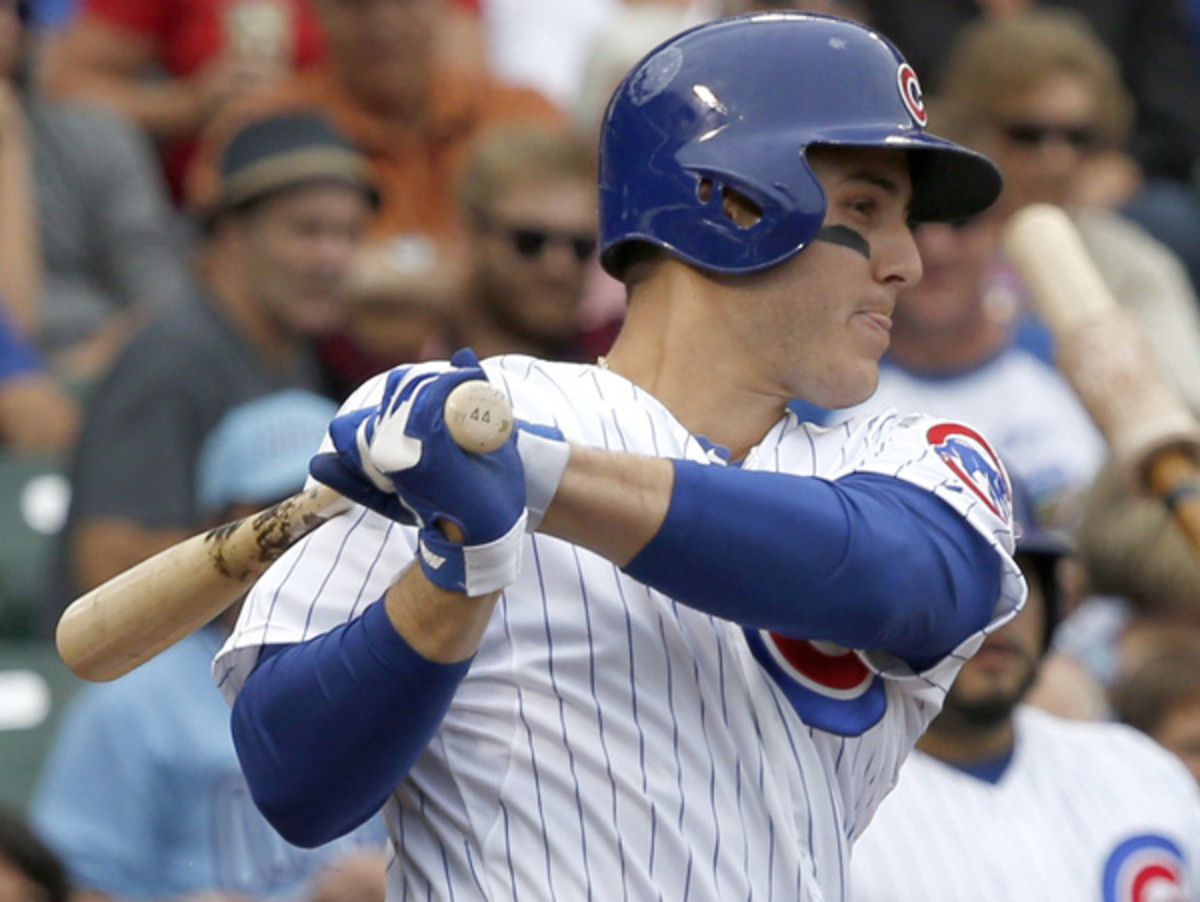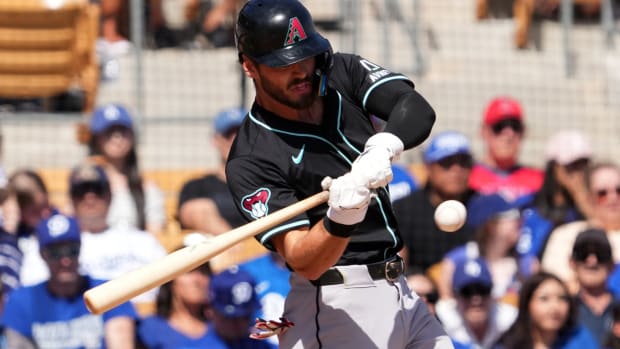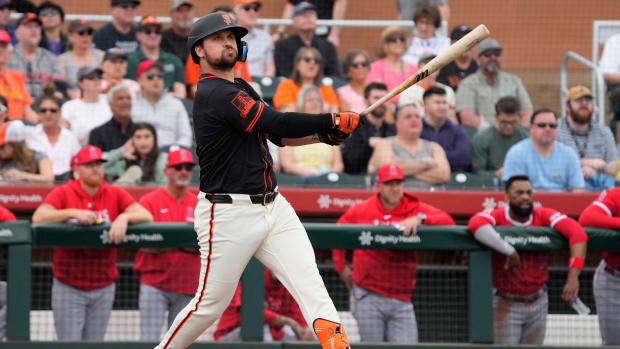
Booms and Busts: First basemen
Anthony Rizzo managed a mere .742 OPS in 2013, but is still just 24 years old. (Charles Rex Arbogast/AP)
Last week, I kicked off my second go-round of Booms and Busts, a series in which I highlighted a small handful of players at a given position whom I expect to take significant steps forward or backward in the coming season. I have no hard-and-fast criteria for those players, no promises of fantasy-league dominance or skyrocketing OPSes for the Booms or slides below the Mendoza Line for the Busts. But between poring over projections, identifying players in changed circumstances such as trades, new roles, recoveries from injury, or entries into the prime age range of 26-29 years old, there are players I'd like to earmark before the season begins, for better or worse.
Note that I won't be including rookies among these picks; those will be saved for another cycle. In the spirit of accountability, I'll also revisit last year's picks at each position, and see what I've learned (or haven't); those picks will be judged on a PASS/FAIL basis as to whether I was right or wrong. Having covered the catchers, it's time to start going around the horn.
BOOMS
Anthony Rizzo, Cubs: After hitting .285/.342/.463 with 15 homers in 368 plate appearances following a late June 2012 recall, Rizzo appeared to be a cornerstone of the Cubs' future, and they rewarded him thusly, signing him to a seven-year, $41 million extension last May. He was hitting a handsome .288/.361/.554 when the deal became official, but skidded thereafter, finishing at .233/.323/.419. Not only was he was eaten alive by lefties (.189/.282/.342 in 216 plate appearances), but his .258 batting average on balls in play was also the league's fourth-lowest mark among qualifiers, 52 points lower than the previous year. Fortunately, strong glovework (+16 runs according to Defensive Runs Saved) prevented him from completely hitting bottom; his 2.6 WAR was respectable. He's capable of much more, and at 24 years old, still has a good shot at improving, particularly given that some of his shortfall may have simply been bad luck; as noted here, his .172 BABIP on groundballs was 68 points lower than league average, enough of an outlier that it's almost certain to improve.
Prince Fielder, Rangers: While I'd prefer to focus on someone younger and less established than this five-time All-Star, his changed circumstances stand out enough that I'll spend my nickel here. Though 2014 marked the fourth year out of five in which he played every game, Fielder hit just .279/.362/.457, numbers that were respectively eight, 31 and 85 points below his previous career norms. His slugging percentage, isolated power (.178) and 25 homers were all career lows, while his on-base percentage, OPS+ (120) and WAR (1.7) were his lowest marks since his 2006 rookie campaign. He looked particularly befuddled at the plate in the postseason, where he hit .225/.311/.250 without an RBI in 45 plate appearances. It's tempting to chalk his mediocre season up to either age or his physical condition catching up to him, but as we now know, Fielder was in the midst of a divorce last year, something that had the potential to cause a significant distraction. He's not that old (30 on May 9) and the change of scenery should help, particularly in moving to a park that's more favorable to left-handed power. Given the quality of his defense — or lack of same — it might not be a bad idea if Ron Washington uses him as a DH more often than Jim Leyland did.
BUSTS
James Loney, Rays: An outburst over the final two months of 2011 aside, Loney's career appeared to be on the downslope coming into last year; he had hit a combined .269/.322/.386 over the previous three seasons while going from the Dodgers' starting first baseman to ballast in the Nick Punto blockbuster to bargain-bin free agent. The Rays scooped him up in December 2012, signing him to a one-year, $2 million deal, and Loney responded by hitting .299/.348/.430; his 13 homers were his most since 2009, his 118 OPS+ was his full-season high, and his 2.7 WAR tied his career high. A closer look suggests that the league caught onto Loney after a torrid start; aided by a .345 BABIP, he hit .331/.392/.531 with seven homers through May, but when his BABIP shrank to a more representative .317 (12 points above his previous career mark), he sank to .283/.328/.382 with six homers thereafter. In January, the Rays rewarded him with a three-year, $21 million deal. He may deliver enough value (WAR) to break even or better over the life of it, but I'm not sure I see the point of committing roughly 10 percent of payroll over the next three years to a guy who might be league-average in his age 30-32 seasons.
Juan Francisco and/or Mark Reynolds, Brewers: To say that things didn't go well for Milwaukee at first base in 2013 may be the understatement of the year. Intended starter Corey Hart was slow to recover from offseason microfracture surgery on his right knee and began the spring on the disabled list; in the process of rehabbing, he injured the left one and needed a similar surgery in July. His intended replacement, Mat Gamel, responded to the opportunity by blowing out the ACL in his right knee for the second year in a row, and the team entered the regular season with former shortstops Alex Gonzalez and Yuniesky Betancourt sharing the job. That yielded predictably terrible results, and so in June the Brewers traded for Francisco, who had previously been sharing third base duties with the Braves. Though possessing outstanding raw power, the lefty's contact woes — a whopping 35.8 percent strikeout rate (229 K per 650 plate appearances) — drained whatever offensive value he might have; for the season, he hit .227/.296/.422 with 19 homers for a 93 OPS+, an unacceptable performance for a first baseman. The Brewers let their imaginations run wild in plotting to shore up the position this winter, emerging with a righty hacker who shares the same strengths and weaknesses in Mark Reynolds. Playing with the Indians (who eventually released him) and the Yankees, he hit .220/.306/.393 with 21 homers for a 96 OPS+ while striking out "only" 30.6 percent of the time. Where's Russell Branyan when you need him?
Last Year's Booms (graded Pass/Fail):
• Yonder Alonso, Padres: Alonso's mid-2012 power uptick, which ran from July through the end of the season, convinced me that he could build on those numbers in his age-26 season. Alas, injuries to his right wrist prevented him from going yonder with more frequency in 2013; in 97 games, he homered just six times and hit .281/.341/.368, meaning that his isolated power dropped from .120 to .087. I haven't given up hope for him, but injuries sadly make this one a FAIL
• Eric Hosmer, Royals: After a standout rookie season, the former top prospect fell into a funk due to bad mechanics and a pull-happy approach, hitting just .232/.304/.359 in 2012. He started similarly in 2013 (.261/.320/.333 though May) but turned his season around via a timeline that coincided with Hall of Famer George Brett's two-month stint as the Royals' interim hitting coach. Hosmer particularly improved against lefties, boosting his OPS against them from .588 to .797 and finishing the year with very respectable numbers overall: .302/.353/.448 line with 17 homers and 3.6 WAR. PASS
• Logan Morrison, Marlins: While I knew the 25-year-old Morrison would start the year on the disabled list as he recovered from a torn patellar tendon, I expected him to miss less than two months, with both his batting average on balls in play and his power recovering. I was right on the former, as he jumped from .248 to .281, but wrong on the latter, as his isolated power slipped from .169 to .143; in retrospect, I placed too much faith that his knee issues would be solved so quickly. In all, Morrison hit just .242/.333/.375 with six homers, and he was nothing to write home about afield, finishing at −0.5 WAR. FAIL
Last Year's Busts:
• Brandon Moss, A's: After passing through the hands of the Red Sox, Pirates and Phillies, Moss enjoyed a breakout 2012 season in a platoon capacity, bopping 21 homers in 296 plate appearances. I didn't think he could maintain that level of production in light of his .357 BABIP and 32 percent strikeout rate against righties. I wasn't entirely wrong; that BABIP split dropped to .300 as his overall batting line dipped from .291/.358/.596 to .256/.337/.522, but he did homer 30 times in 505 PA, and his 139 OPS+ was still plenty good. Lousy defense (-14 DRS) prevented this from being a laugher, limiting him to 2.2 WAR compared to 2.0 in 2012, but I can't claim victory here. FAIL
• Justin Smoak, Mariners: Some were convinced that Smoak's strong September 2012 showing offset the 1,320 plate appearances that preceded it, but I wasn't buying. While his .238/.334/.412 performance was an improvement upon the .223/.306/.377 he hit prior, lousy defense (-8 DRS) limited him to 1.1 WAR, a below-average showing for a full-time player. He's still apparently got a job, though the arrivals of Morrison and Corey Hart mean that the Mariners again have plenty of alternatives. PASS
Scorecard: 2 PASS, 3 FAIL
Running total (all positions thus far):



































